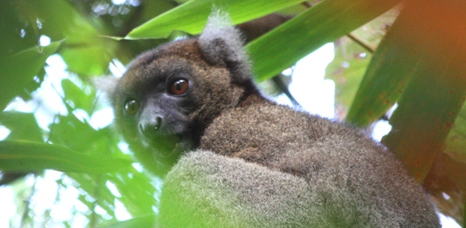Lynda Sharpe travelled on our 'Madagascar' holiday and submitted this entry to our writing competition.
Greater Bamboo Lemur by Lynda Sharpe
We were sitting on a wet, slimy boardwalk watching tiny leeches inch their way up our mud-caked boots. Huge trees loomed all around, their foliage heavy and dripping from a recent downpour. Dark clouds still pressed low, making the forest as gloomy as I was feeling. The conversation didn’t help. My companions were debating how long a species could remain unseen before it should be declared extinct. There was good reason for both the topic and our despondency. You see we were awaiting the impossible.
How did we get into this predicament? Well, we’d clambered up this steep, slippery hillside, in the rainforest of Ranomafana National Park in Madagascar, in the hopes of glimpsing one of the world’s rarest primates. Critically endangered, the greater bamboo lemur (Prolemur simus) once roamed throughout the island of Madagascar; now it clings on in just 12 isolated forest fragments. Fewer than 200 of the critters draw breath. We’d been shepherded up to this isolated spot by our park guide and his posse of ‘wildlife spotters’. Before this crew headed off into the trees to search out the lemurs, our guide explained that they were seeking the ONLY group of greater bamboo lemurs in Ranomafana National Park.
‘You mean it’s the only one tourists visit?’ we suggested hopefully.
‘No, no. There is just one.’
We stared at him non-plussed.
He explained that the group’s nearest neighbours lived 200 km (124 miles) away in a forest remnant on the slopes of the Andringitra massif.
Oh! We asked how many were in the group.
‘There used to be eight, but when we last found them, there were only two left.’
‘When was that?’ a brave soul asked.
‘Six weeks ago.'
Ahh.
We were still standing gob-smacked, opening and closing our mouths like goldfish, when the guys left us. We didn't get a chance to holler, ‘Why are we squandering our time in this wonderful park pursuing phantoms??!’
So we waited.
Miserably.
Now don’t get me wrong. Bamboo lemurs are worth investing time to see. They’re intriguing critters. With atypical accuracy, their common name really does reflect their tastes: they dine almost exclusively on bamboo. The problem is, giant bamboo (their all-time favourite) stuffs its tasty young shoots with taxiphyllin. When digested, this stuff breaks down into deadly hydrogen cyanide. The bamboo’s branch shoots (which thrust up out of the ground like whopping asparagus spears) are the most heavily fortified, toting 15-40 mg of cyanide per 100 g of shoot (the lethal dose for a 60 kg human is 30 to 200 mg; fortunately, cooking destroys the cyanide; unfortunately lemurs don’t cook). No one knows how bamboo lemurs cope. The golden bamboo lemur, who prefers to dine on the branch shoots, routinely guzzles 12 times the lethal dose.
However, the wonders of lemur physiology weren’t uppermost in our minds as we sat hunched beneath the dripping trees. Our conversation had lapsed into a silent contemplation of the nature of loss (or the loss of Nature). We weren’t listening to the surround-sound screech of frogs, cicadas and other unseen stridulators; we were staring off - unseeing - into the eerie, primeval gloom. One of our group, looking up at the huge bamboo thicket looming above us, said chirpily (in a transparent attempt to lighten the mood), ‘I keep expecting to see fairies or something suddenly pop out.’
And within a matter of minutes they did.
It started as a rustling overhead, and then a clump of bamboo canes swayed wildly as something dark clambered down among them. We snatched up our binoculars and jostled one another for the best view of the moving fronds.
OK, there was some fur...
Oh, and look a tail.
Yes, yes, they’re lemurs for sure ... But what sort?
Oh my God!
The impossible had happened.
Above our heads, the last two greater bamboo lemurs in Ranomafana National Park were nibbling bamboo!
About the size of small house cats and clothed in dark brown fur, they sinuously wound between the bamboo canes. One peered down at us, his bald nose and prominent grey ear tufts giving him a nutty professor look. As we watched, he bit into the woody stem of a bamboo cane, clasped the edge of it in his teeth and pulled down a strip of wood to reveal the soft pith inside. This he munched with enthusiasm. Greater bamboo lemurs are alone in using this part of bamboo plants. We were still gabbling euphorically when our lemur spotters came trudging back (10 minutes after the lemurs had disappeared up the mountainside). Sweaty and bedraggled, they shook their heads sadly and apologised for their failure. We responded with an uproar of excited exclamations. As they peered at the images on our cameras, their eyes widened and smiles broke out all round; there was much back-slapping and laughter. I was deeply heartened by their obvious joy in the continued existence of their lemurs.
As we slipped and slithered back down the muddy track, we talked excitedly of our incredible good fortune in seeing these rarities. But somehow our jubilation and sense of privilege just couldn’t shift the underlying weight of despair. These creatures were almost certainly doomed. I found myself wishing that I could give the good luck back; somehow pass the blessing over to the lemurs, like a vial of golden Felix Felicis (Liquid Luck). They were going to need every drop they could get.
Read more about our 'Madagascar' holiday.



 Loading search...
Loading search...
